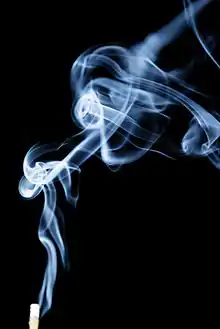Mysore Agarbathi
Mysore Agarbathi is a variety of incense sticks manufactured at Mysore using locally grown ingredients which was found only in state of Karnataka before. This incense has been awarded Geographical Indication tag from the Government of India in 2005 due to its historic background and remote availability of material used.[1][2] Aptly, Mysore is also home to the world's largest manufacturer of agarbathi - N. Ranga Rao & Sons popularly known for the Cycle Pure Agarbathies .

History
The making of incense sticks, also called 'agarbathi' in Hindi, became an organised industry in Bangalore during the 1900s and was locally known as oodabathies (blowing fumes). The incense sticks were very simple to manufacture, as it was only a paste of natural ingredients mixed with charcoal and Gijit, and rolled on to bamboo sticks. The proportion of mixing was of main importance. Maharaja of Mysore was patronised the production and promotion of the incense sticks.[3] Mr T.l Updhayay from Thirithalli shimoga & Attar Khasim Sahib from Tanjavur started insence industry in mysore on 1885 and won certificate of merit from wembley exhibition, london. This made the then mysore local government to disperse the insence sticks as gifts to visitors and guests from other land and since then with various industrialists have grown the local industry by exporting it to other countries.[1]
Method of manufacturing
Herbs, flowers, Essential oil, barks, roots, charcoal are finely ground into smooth paste and then rolled on to a bamboo stick and then dired undersun, special wood like sandalwood, Ailanthus malabaricum which yields halmadi and other natural ingredients were geographically only available in Karnataka before which gives special geographical indications
Geographical Indication
The all India agarbhati association proposed the registration of Mysore Agarbathi under the Geographical Indications of Goods Act, 1999, to the Office of the Controller-General of Patents, Designs and Trademarks, Chennai, in order to make it exclusive the manufacturers of insence sticks who use only local available natural ingredients from the region to use the name Mysore.[1] It was granted the Geographical Indication status, three years later, in 2005.
See also
- Mysore Sandalwood Oil
- Mysore Sandal Soap
- Mysore pak
- Navalgund Durries
- Coorg Green Cardamom
- List of Geographical Indications in India
- Incense Route
- Kōdō, incense arts
References
- "Geographical Indications Journal No. 4 Application Number 18" (PDF). Geographical Indications Journal. Government of India (4). 2005. Archived from the original (PDF) on 10 April 2009.
- "CM asks Centre to reconsider decision on IIT in Dharwad". Deccan Herald. 2015.
- DODDAMANI, CHANDRASHEKHAR. "CLUSTER DEVELOPMENT PROGRAMME, INDIA DIAGNOSTIC STUDY ARTISAN AGARBATHI (INCENSE STICK) CLUSTER MYSORE (KARNATAKA)" (PDF). NEw Delhi: UNIDO. p. 3. Archived from the original (PDF) on 9 January 2014.